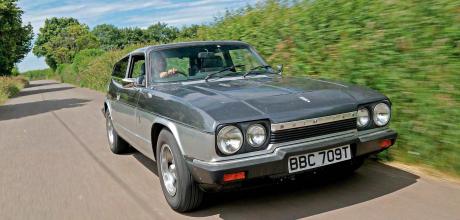1979 Reliant Scimitar SE6a diesel conversion
The Reliant Scimitar is a sporty and practical four-seater, but Drew Thomas’ example needed more torque and better fuel economy. His solution was a diesel conversion…
LIVING BY THE SWORD
Regular readers will recall our previous features on Drew Thomas’ homebuilt diesel classics. There is his Volvo Amazon and Land Rover 88, and this Scimitar is the third in the trilogy.
“I had originally planned for this one to be electric,” says Drew. The electric Scimitar; sounds like a folk music act from the 1960s… “I bought it in July 2015 from a guy in east London. The MOT had just run out and the guy was desperate to sell the car. The main reason I bought this car was because it wasn’t rotten. It was the best example I’d seen and I even liked the colour. I’d been dealing with rust on the Volvo and wanted a glassfibre-bodied car.”
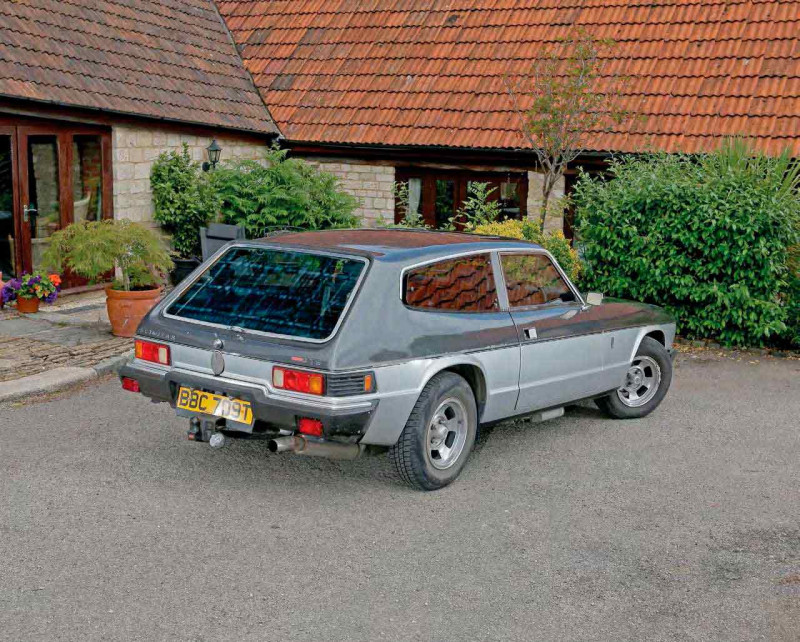
“As I say, the plan was to make it electric,” continues Drew, “so I’d bought an airport tug. Not one of the ones that pulls aircraft, this was a Elcat Cityvan; a Subaru Sumo converted to battery electric power in Finland. It was ex-Gatwick Airport and I’d initially purchased it to electrify my Datsun 120A, then changed my mind. After spending £1,000 on new batteries and another £500 for a new on-board charger, it owed me about £2,500, but the van was proving unreliable, whereas the Datsun was a nice car I’d previously restored that never gave any trouble.”
“Part of the problem was the van needed these expensive lithium batteries, but the final nail in the coffin was when I realised it was limited and geared for a maximum speed of 40mph – great for around town driving, but not much else. Certainly not on the motorway towing a small caravan as I had in mind.”
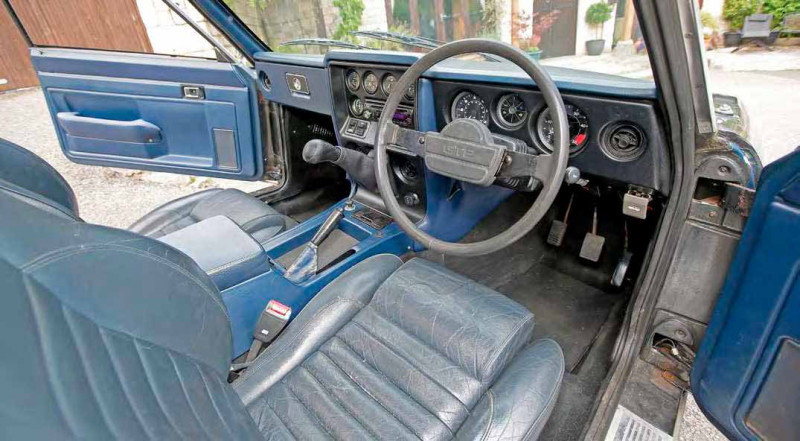
“Meanwhile, the Scimitar in completely standard condition was only returning about 22mpg and had a tendency to overheat. By now I’d had the chance to examine it thoroughly and although the body wasn’t bad, there was rot underneath in the steel chassis frame – these cars are renowned for that since all the rust is well hidden and they’ll go through MOTs for years until they’re really hanging. I’d only then considered making it diesel for reliability, and because it was something different.”
“Once I got the Scimitar over my pit, I could tell precisely how rusty it was. I pulled out the interior, then ground out all the bolts that attached the body. There are, from memory, 16 bolts and not one turned, even a millimetre. I stripped the Scimitar down and had the chassis shotblasted, replaced the rotten areas – many hours of welding – then had it galvanised.
“After a bit of measuring, I chose the same engine I’d put in my Land Rover; the 2.9-litre SsangYong turbodiesel from a Musso 4x4. It’s basically a Mercedes-Benz motor and I knew the engine well by now, reasoning it’s simpler having two the same if something does need repairing. They’re pretty much bulletproof, and I got this one from eBay.
“This wasn’t an easy conversion...”
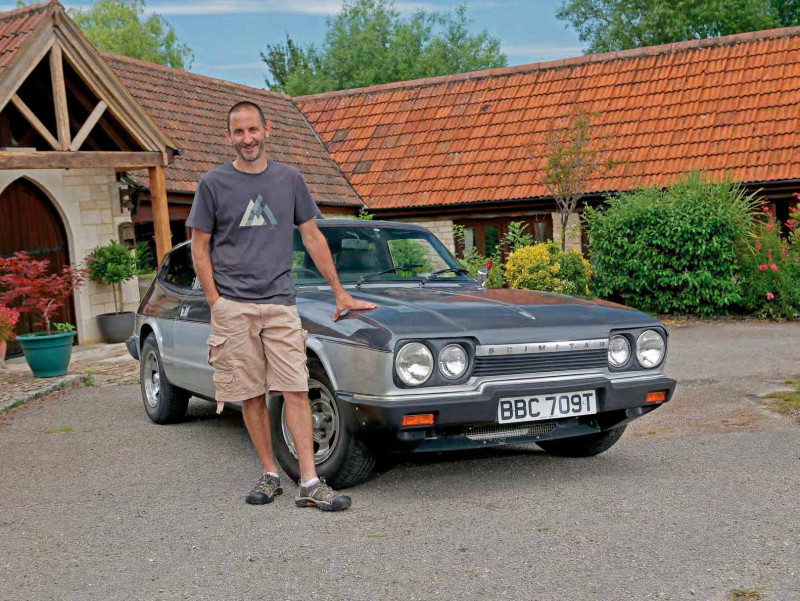
Once I’d mocked the engine and gearbox into place, I dropped the Scimitar body back on and essentially cut away any areas of the body that didn’t fit, then fibreglassed in new sections. The firewall is now recessed four inches further back than standard, but not being of monocoque construction, that doesn’t affect the car’s strength. I altered the engine mounts, starting with Ford 3.0-litre Essex ones that I fitted after welding captive nuts to the chassis. The gearbox mount was based on the original, but modified with a step in the centre to lower it slightly.”
Engine Room
“This wasn’t an easy conversion, because although there’s a good amount of space under the bonnet, it’s all in the wrong places,” admits Drew. “Initially, the crossmember fouled the sump and mounting the engine any further back would have meant cutting open the transmission tunnel, and I really didn’t want to do that, so I fitted the sump from a Mercedes-Benz W124 diesel. As it was, I had to fit a remote oil filter and relocate the alternator, since it would have hit the chassis rail – for that I built new mounting brackets. The throttle cable is by SsangYong, as is the fuel pump. I bought a second-hand stainless steel fuel tank and welded in a fuel return line. I also fitted the SsangYong bonnet release after the original Ford one broke.”
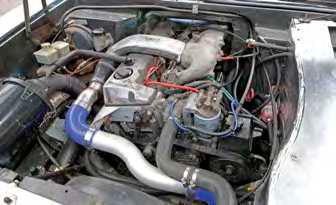
“This diesel engine is definitely lighter than the Essex 3.0-litre Ford V6 that was previously in there. When I pulled the Essex out, the engine hoist was straining, but it lifted the Mercedes-Benz motor without any problem. I don’t know the weight difference, although the Merc lump has an alloy head.”“I used a Mercedes-Benz Sprinter five-speed gearbox and that’s definitely lighter than the original ‘box too. The gearbox was £30 from eBay and fifth gear is a higher ratio than the overdrive was on the standard Scimitar. I had to drastically cut down the gearstick, since being made for a large van, it was almost touching the headlining of the Scimitar!” Through some clever bending work into an S-shape, the gearlever now emerges through what used to be the aperture for the heater controls. “The original Ford one had such slack rods that whatever I did I couldn’t have made it any worse.”
Incidentally, the Scimitar was originally an automatic, so Drew bought a manual pedal box and used the Mercedes-Benz Sprinter clutch. The radiator came from a Nissan 200SX, “chosen mainly for its dimensions, it came from eBay, and I made up the mounts and pieced together hoses to fit it. The running gear is totally standard mechanically.
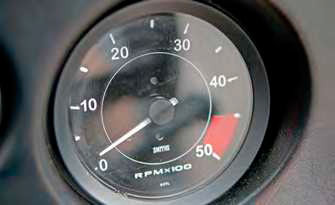
The brakes are stock and so is the rear axle, other than the suspension having uprated coilover springs. The tyres are 185/80 R14 in size, and the spare wheel, which would usually live in front of the engine, is now a space saver from a Volvo. I discovered on a forum that the stud patterns are shared.” The rev counter is also SsangYong, “but with the guts of a Smiths gauge, while the speedometer drive came from eBay. That’s where most of the parts come from now,” says Drew wistfully, “I used to be in the local scrapyards every Saturday finding parts like hoses and other bits I could use, but so many of them are closing down or just full of newer cars with sealed for life components. The Mercedes-Benz had an electronic speedometer, whereas the Scimitar’s was cable operated, so a Smiths electronic item was fitted. It works off the propshaft, which has magnetic bolts, by which it counts the revolutions. I had to calibrate it at 500rpm over a measured mile. I spent most of a day driving up and down to ensure that it was done correctly.”
The rev counter required some creative thinking, “the SsangYong one worked off the alternator, while the Scimitar rev counter is fed from the coil, so I took out the SsangYong counter’s interior workings and put them in the Scimitar dial’s body. I then resprayed the Scimitar dial face and added lettering to mimic the Ssangyong’s numbering.”
Cheap and Easy
The headlining is the same material used for upholstering the seats in coaches, “it’s hardwearing, easy to cut and best of all cheap and easy to source.” Which is Drew’s ideology in a nutshell, modifications don’t have to be expensive or fancy, they just have to be as good or better than what was previously there.
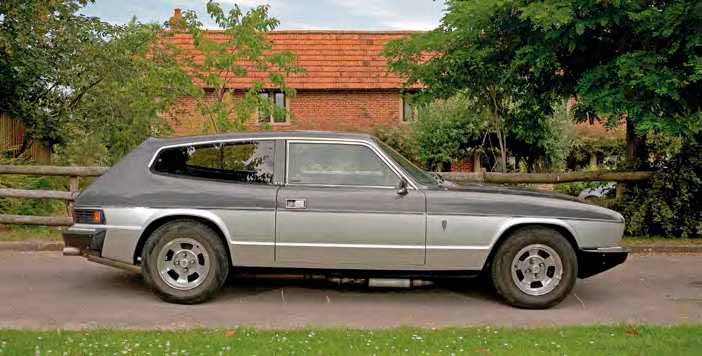
“The windscreen is a heated one that was bought from the club for £200.” Also heated are the seats, which originally lived in a Jaguar XJ-S. “I put in heater pads from eBay – I wanted a classic I could drive through the winter. The heater now has the matrix from a Range Rover – it’s just a simple box; put cold air in, warm air comes out. However, I’m going to fit air conditioning, since it gets warm inside in virtually any weather. I recently fitted air conditioning to the Volvo and it works really well.”
“I also made motorised catches for the Scimitar’s rear windows using Ford Ka hinges with window motors from a BMW E46 Coupé, so I can now open them while driving. The rear windows are specially cut toughened, tinted glass. I’ve a friend who makes glass for buses who did them for £16 per pane. I used Citroën Xsara Picasso door rubbers.”
“It all took about 18 months of evenings and was definitely worthwhile, although it was a lot more work than I’d anticipated. Having a separate chassis, I expected things to be easier, but when you’re lifting a body on and off all the time, even with fibreglass, it’s heavy. It certainly goes well and has a nice exhaust note.” The exhaust is the standard downpipe with a Land Rover middle box and pipes from eBay, “it sits very low though, as does the sump, that’s perhaps the only downside of the conversion, but there wasn’t much I could do to avoid that.”
“The Scimitar is now reliable and has been brilliant right from the first day. I’d learned a lot from the conversions on the Land Rover and Volvo. In terms of cost, I paid £1,200 for the car, £200 for the engine and £35 for the gearbox. The propshaft was £290, the fuel tank another £40, the speedometer conversion cost £180, while the rev counter was donated by my good friend Dean.”
“I’m one of a few in the Scimitar Owner’s Club who uses his car all year around,” adds Drew, “they weren’t sure what to make of it at first, and a handful certainly turned up their noses, but I needed the car to be reliable and tow a small caravan and the torque now is fantastic. The ones who said they didn’t like it got the offer to try driving it and usually changed their opinion. Running on vegetable oil I get about 50mpg. However, the general mood of the world now seems to be changing back to electric cars again, so I’d still really like to try building a battery-powered classic, once the prices of suitable parts drops a bit.”
By Royal Appointment
We almost managed it. We almost got away without mentioning that Princess Anne owned a Scimitar. In fact, she’s owned nine, receiving her first, a blue SE5, as a present from her parents in November 1970. She also owned the last Scimitar built, and apparently still owns a 1989 Middlebridge version. Middlebridge Scimitar being the company that acquired the manufacturing rights and tooling of the Scimitar GTE and GTC models in 1987.
It’s hard to believe this Scimitar is from the same company that offered a variety of three-wheeler cars. Reliant was founded in 1935 in Tamworth, Staffordshire and initially built motorcycle-style light three-wheeled vans with aluminium bodies, gradually moving to fibreglass bodies in the mid-1950s. The Reliant Rebel was their first four-wheeled car, based around the three-wheel Regal, but with Triumph Herald front suspension.
The Scimitar name was first applied to a Reliant-built sports car in 1964. An attractive coupé known by the model designation SE4A, it used a Ford 2.6-litre straight six from the Zephyr/Zodiac and was replaced by the SE4B two years later. That car came with Ford’s 3.0-litre Essex petrol V6, although a cheaper 2.5-litre SE4C version arrived in 1967.
The royal connection came about through a special bodied SE4 estate built when Triplex wanted to promote their new Sundym laminated glass. Prince Phillip acquired the GTS (Glazing Test Special) for his personal use after it was shown at the 1965 Motor Show and the resulting publicity lead Reliant to develop a practical production version known as the GTE.
Thus, the four-seater Scimitar GTE shape featured here, debuted in 1968 as the SE5. Designed in 12 months and based on the SE4, the new model featured a brand new sports hatchback body and a chassis that included revised suspension. Under the bonnet was the same Essex V6, with the option of an automatic transmission added in 1970 and overdrive for the manual four-speed the following year.
The SE5A arrived in 1972 having various updates, including seven more bhp and a curved plastic dashboard. The 5A would prove to be the best-selling Scimitar with a production run of 5,105. The Scimitar SE6 went on sale in 1975 with a four-inch longer wheelbase and three-inch wider track, which improved rear legroom. The SE6A debuted in 1976 boasting improved suspension and brakes, with production totalling 3,877, making it the most popular SE6.
After Ford stopped producing their Essex engine for the Capri in 1981, the SE6B came with the replacement 2.8-litre Cologne V6, along with various necessary front chassis adjustments.
A four-seater GTC convertible model was added in 1980 and was soon available with an optional hardtop. However, a recession made the cars increasingly hard to sell and Middlebridge Scimitar acquired the manufacturing rights in June 1987, producing them from 1988 with over 450 modifications, including galvanised chassis and fuel injected 2.9-litre Ford engine.
Prince Phillip and Prince Andrew were also Scimitar GTE owners, but it was after Princess Anne was famously caught by police speeding down the motorway at 90mph in hers that mentioning her name in connection with the car became virtually a UK law.
Innovative as they were, Scimitar never offered a factory diesel version, although Ferguson did build one four-wheel-drive prototype. Today the Scimitar GTE remains a much underrated and undervalued classic car. Find one with a solid chassis and you can’t go far wrong. Just watch out for practical jokers, we heard of one owner who found the badge letters on the front of his car swapped around to spell IMRACIST…
FACTS & FIGURES
- Built in Tamworth, UK
- Codename SE6a
- Bodystyle 2-door estate, 4-seats
- Layout Rear-wheel-drive
- Powerplant 2,874cc, 5-cylinder, 10-valve, turbo diesel
- Gearbox 5-speed manual
- Max power 118bhp @ 4,000rpm
- Max torque 188lb ft @ 2,400rpm
- Top speed 120mph (estimated)
- 0-62mph 11.0secs (estimated)
- Economy 51.2mpg
- Fuel tank 82 litres
- Range 921 miles
- Size (length/width without mirrors) 4,320/1,709mm
- Boot space 1,133 litres
- Kerbweight 1,293kg


